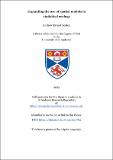Files in this item
Expanding the use of spatial models in statistical ecology
Item metadata
| dc.contributor.advisor | Illian, Janine | |
| dc.contributor.advisor | Borchers, D. L. | |
| dc.contributor.advisor | Glennie, Richard | |
| dc.contributor.author | Seaton, Andrew Ernest | |
| dc.coverage.spatial | 244 | en_US |
| dc.date.accessioned | 2024-02-21T10:46:43Z | |
| dc.date.available | 2024-02-21T10:46:43Z | |
| dc.date.issued | 2022-06-14 | |
| dc.identifier.uri | https://hdl.handle.net/10023/29306 | |
| dc.description.abstract | This thesis is focused on expanding the use of spatial modelling approaches for applications in ecology. Spatial ecology is about understanding the processes that give rise to spatial patterns in ecological data. In addition to developing a purely scientific understanding, insights into these processes are essential for the effective monitoring and conservation management of ecological systems. However, for many ecological problems, the detectability of animals is imperfect, requiring the use of complex observation models that can account for this. In this thesis we focus on two such models: distance sampling and spatial capture-recapture (SCR). For both these models we incorporate spatially structured random effects to provide a non-parametric method for describing spatial variation in species’ abundance, and to address the problem of spatial auto-correlation. These complex models require the use of computationally efficient random effect structures and inference methods. In particular, we use a sparse stochastic partial differential equation (SPDE) approach as well as low rank penalised smoothing splines. We also draw links between these two approaches in order to illuminate the technically challenging results underpinning the SPDE approach. For inference in distance sampling models, we use a novel approach to achieve a one-stage model fit based on iterated model fitting using approximate Bayesian methods. For inference in SCR models, we use Laplace approximate maximum likelihood methods. We present models that have the necessary complexity to jointly model complex ecological and observation processes, as well as providing efficient methods to fit the models in practice. We conclude by discussing related avenues for future research that are motivated by applied problems in the field of spatial ecology. | en_US |
| dc.language.iso | en | en_US |
| dc.publisher | University of St Andrews | |
| dc.subject.lcc | QH541.15S62S4 | |
| dc.subject.lcsh | Spatial ecology--Mathematical models | en |
| dc.subject.lcsh | Ecology--Simulation methods | en |
| dc.subject.lcsh | Animal populations--Estimates--Statistical methods | en |
| dc.title | Expanding the use of spatial models in statistical ecology | en_US |
| dc.type | Thesis | en_US |
| dc.contributor.sponsor | Engineering and Physical Sciences Research Council (EPSRC) | en_US |
| dc.type.qualificationlevel | Doctoral | en_US |
| dc.type.qualificationname | PhD Doctor of Philosophy | en_US |
| dc.publisher.institution | The University of St Andrews | en_US |
| dc.identifier.doi | https://doi.org/10.17630/sta/783 |
This item appears in the following Collection(s)
Items in the St Andrews Research Repository are protected by copyright, with all rights reserved, unless otherwise indicated.

